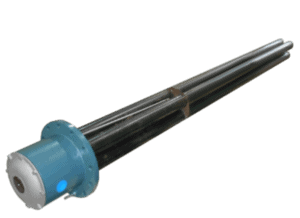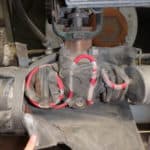
There is a long debate about the direct comparison between steam heating and electric heating efficiency across many applications. Today, we will discuss specifically the use of steam and electric immersion heaters to heat large tanks in industrial applications.
First, let’s define each one:
Steam Coils in Tanks
Large tanks are fabricated with coils in the bottom of their tanks.

These coils are designed to hook up to a system that provides steam that is pushed through these coils. Coils are normally installed internally to the tank, though in some cases they wrap the outside of the tank with a steam jacket. Steam pushed through the coils then will transfer heat to the contents of the tank. As steam temperature increases or decreases, so do the contents of the tank.
The calculations required to decide how to heat a tank with steam have to contend with something called the “U-value”. As steam is pushed into the coils, it is hot and has plenty of energy to heat tank contents. As the steam moves along through the coils, it loses that thermal energy and eventually wants to turn back to water as it decreases in pressure and temperature. The longer the coil system, the more difficult it is to carry the heat. Coefficients are used in calculations that allow for consideration of average temperature along the coil system. This creates a system that must be much hotter than needed at the start, so it will be hot enough later in the coil in dealing with thermal losses along the way.
Electric Immersion Heaters
Electric immersion heaters are installed in tanks through a flanged or NPT connection. Voltage is applied to the heater, and electric elements are energized through electric heating elements. As those elements on the heater get hot, they can then transfer heat to the tank contents. Control systems monitor both the tank content temperature and the heater sheath temperature to make sure both stay within acceptable limits.
Both steam and electric heaters have their strengths and weaknesses. Let’s start with a look at steam.
What are the advantages of having a steam heating system?
Steam produces a high level of heat energy and can be very effective at many temperatures. The amount of energy created for the amount of energy applied has always been the big attraction for steam use. Many facilities have excess or “free” steam which can make it very economical. Military use of steam on submarines and navy ships, for example, will always produce personnel that are familiar with all of the working parts needed to run a steam system.
Steam heating drawbacks
Steam coils can become fouled, which is a build up of sediment and debris on the coil surface. (https://www.google.com/search?q=What+is+fouling+of+steam+coil+surface%3F&rlz=1C1GCEA_enUS938US939&oq=What+is+fouling+of+steam+coil+surface%3F&aqs=chrome..69i57j33i160l2j33i299.7718j1j7&sourceid=chrome&ie=UTF-8) In fact, a 10% allowance is often required in steam coil design to allow for inefficiencies in steam coils due to fouling. Fouling can be reduced by draining the tank and cleaning the coil surface which creates tank downtime and lost production.
Calculations used for heat up with steam demand a much higher temp at the beginning of the coil, and lower temp at the end. Many products cannot handle this large swing in temperature across the coils, so averages must be used in the calculations. Averages are tough when you are trying to produce a precise product.
Steam coils are most often made of stainless steel, and while this is a fantastic material selection for transporting steam and condensate, it’s not made to transfer heat. Users must rely on that stainless coil to transfer the heat to their process. The measurement used to determine how well a product transfers heat is called specific heat. Water has a specific heat capacity of one btu per pound per degree (1.0 btu/lb/℉). Stainless steel is only rated at .12 btu/lb/℉. It’s effectiveness in delivery of heat through it’s coil wall is very low.
Steam coils also require maintenance on many specific parts of it’s process:
- Steam Traps
- Water quality maintenance
- Burner maintenance
- Condensate water return
- Specific staff to maintain
- Creating a much higher level and frequency of daily maintenance.
Steam heaters are an older technology with a good track record, but the benefits of electric heat efficiency can’t be denied. Many companies swear by electric heating due to the following advantages:
How efficient is electric heat?
When voltage is applied to an electric heater in a tank, every ounce of that voltage is delivered to the heater, and every ounce of that energy is delivered to that specific process.
Electric heaters are most often installed directly in the tank process, providing direct contact with the product needing to be heated. Electric heaters are more effective at transferring heat from the heat source directly to the product needing to be heated.
Immersion heaters are the most common method of electric tank heating. When installed, they can provide consistent delivery of heat through their heating elements. Element temperatures are precisely controlled and monitored throughout the entire line, providing consistent heat along their length.
Maintenance with an electric immersion heater is much easier than steam tank heaters. Heater voltage and amperage need to be checked to confirm that the heater is in working order. Doing so is some of the best preventative maintenance you can do.
Control systems paired with electric heaters provide an easy user interface via a wide offering of communication protocols, such as Wireless, Ethernet, Profibus TCP/IP and others. Heater performance can easily be monitored remotely, and only a few points need to be monitored to ensure all is working well.
One of the biggest benefits of immersion heaters in terms of maintenance is that the heaters can be configured in a way that allows the mounting flange to remain in place while the element is removed for service, all without having to drain the tank.
Electric heat disadvantages
Many electric heaters are installed with no element monitoring control at all. This can cause heaters to run high temperatures if they lose their primary temperature control sensor. Placing a sensor connected to a proper controller on the heater sheath is a must if your product is sensitive to high heater sheath temperatures. Make sure your system has one.
Poor tank temperature sensor locations will also sometimes cause electric heater failure. Where a tank owner chooses to place the key sensor that tells them what the tank temperature is can be a location that is less than optimal for the heater performance. For example, placing a temperature sensor (TI) at the top of the tank will not be accurate for long- as soon as product is taken from the tank, it is no longer measuring tank content temperature. This signal is often used to control the heater also. When the TI is measuring tank air temperature vs. tank content temperature, the heater has to respond and deliver more heat. That could be a problem.
Finally, tanks are often designed with heaters that require the entire tank to be drained in order to replace the heater. As described above, there are better options, including heaters that are configured to be replaced without having to drain the tank.
What’s Best for Your Heat Plan?
Your tank heating needs are of great importance. We understand that, which is why our engineers are available to help you choose the best industrial tank heater for your processes. Discuss your heat plan with Powerblanket today!
Frequently Asked Questions
What are the different types of steam heating coils?
Steam heating coils come in various types, including standard coils for general applications, centifeed coils for more uniform heat distribution, and tandem coils for systems requiring multiple coil sections, each designed to optimize heat transfer based on specific tank and process requirements.
How does a steam heating coil work?
A steam heating coil works by circulating steam through tubes within the coil, where the steam transfers its heat to the tank's contents as it condenses, effectively raising the temperature of the stored material.
How to design tank heating coils?
Designing tank heating coils involves considering factors such as the tank's size and shape, desired heating rate, fluid properties, and selecting appropriate materials to ensure efficient heat transfer and ease of maintenance.
What is the importance of steam heating coil that is provided in some cargo tanks?
Steam heating coils in cargo tanks are crucial for raising the temperature of stored liquids, reducing their viscosity to facilitate easier pumping and handling, and are also used in processes like electroplating and metal treatment.
Powerblanket's custom tank heaters provide freeze protection, making your business more sustainable and efficient.




